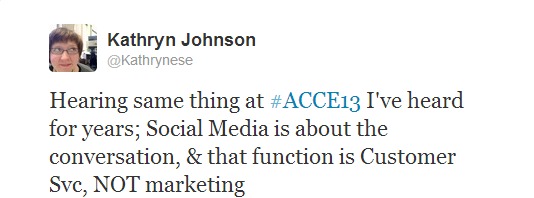By
Jeff Toister
|
Date Published: May 20, 2013 - Last Updated August 22, 2018
|
Comments
This post originally appeared on the Toister Performance Solutions Blog on May 16, 2013.
I attended ICMI's ACCE 2013 conference in Seattle, WA last week. This was the 10th anniversary edition of the premier global gathering for contact center professionals.
If you are like me, you find it hard to keep track of all the brilliant ideas, inspiring speakers, and helpful contacts you come across at a conference like this. And, it's sometimes just too difficult to choose between going to one session or another!
With this in mind, I’ve put together a brief recap of some of the conference highlights.
Conference Overview
You may want to start by familiarizing yourself with the conference if you didn’t attend.
Twitter Backchannel (Tip: you don't need a Twitter account to view the conversation)
Conference Overview
Session Descriptions
I owe a special note of thanks to Voiance Language Services for giving out copies of my book, Service Failure. They made me feel like a star. When people asked how to get my book I was able to send them over to Voiance’s booth in the expo hall!
Conference Themes
Three themes really stood out for me.
Theme #1: Multi-channel customer engagement
Contact centers are interacting with customers in more ways than ever before. We’ve moved beyond phone and email to engage customers with chat, Twitter, Facebook, Pinterest, text, mobile, and other means. Some customer conversations span multiple channels which makes keeping track of everything even more challenging.
Kathy Hutchens from Sharp Rees-Stealy and David McCann from Varolii co-presented an interesting session on this topic. They talked about ways that Sharp Rees-Stealy Medical Centers engaged customers through multiple channels by learning and acting upon customer preferences. Hutchens gave the example that picking the right channel for appointment reminder notices reduced appointment no-shows by 25 percent.
Many participants told me their companies are still struggling to determine who owns some of these channels. I think this Tweet may have said it best:

Theme #2: Technology + People = Success
Technology was a hot topic. It dominated the exhibit hall. Many participants were in search of new technology solutions for their contact centers. It was even a hot topic on the call center tours.
The most successful uses of technology also accounted for the people using it. For example, technology is making it easier than ever before for contact centers to utilize home-based agents. I toured the Starbucks call center where I learned some of their best people practices for making home-based agents successful.
The tour featured a coffee tasting hosted by some of the contact center employees (known as Partners as Starbucks). One of our hosts was a home-based agent who participated via conference call. Their home-based agents regularly participated in these types of events to maintain their connection to the team.
Theme #3: Resource Constraints
Many contact centers don’t have a lot of resources. This puts a lot of technological solutions out of reach, but they still have to find a way to get the job down.
One example came from Tamara Taylor and Dorian Anid at Abbot Vascular. They were part of a session on creative solutions at small call centers. Taylor and Anid used Microsoft Access to create their own CRM system after their request to buy a technology solution was denied. Their homemade system has helped reps work more effectively, but it is also enabling Taylor and Anid to gather data to make a business case for a more robust solution.
I also participated in a roundtable discussion about gathering voice of the customer feedback. The discussion was hosted by Josh Chapman from Cars.com. Chapman’s company employs a lot of sophisticated tools and third-party research firms to gather useful VOC data. This makes sense for Cars.com, but what about a small contact center with no budget for VOC? The roundtable participants discussed a simple solution where the contact center could leverage their company’s existing Survey Monkey account to start a rudimentary VOC program at no cost. It was a small step, but would still yield data they could use to improve customer satisfaction.
On a side note, Josh Chapman was one of several people honored at ICMI’s Global Call Center Awards Dinner. He won the Customer Service Business Leader of the year award and created a memorable moment where his wife tuned into the ceremony via Facetime to see his acceptance speech.
If you attended, what were your biggest take-aways?